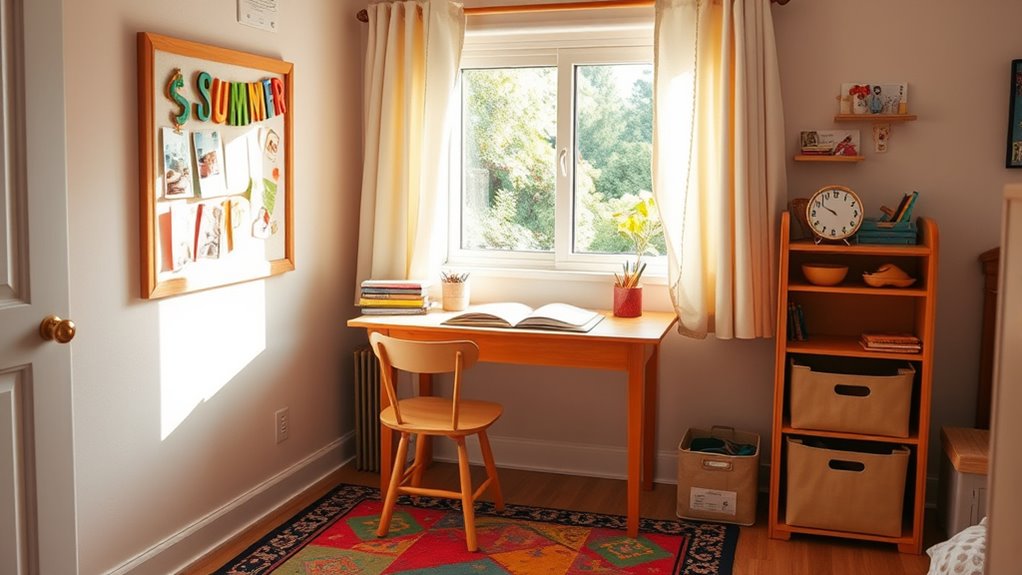To smoothly shift from summer camp to school, start by establishing a consistent bedtime and wake-up schedule, gradually reintroducing structure to avoid overwhelm. Plan and prep supplies and outfits in advance, reconnect with morning and evening routines, and set clear expectations. Adjust nutritional habits for busy days and create a dedicated space for homework. Stay positive and build excitement for the new year—keep exploring for more tips to make this change seamless.
Key Takeaways
- Gradually reintroduce school routines by balancing free time with planned activities similar to summer camp schedules.
- Prepare supplies, outfits, and checklists ahead of time to reduce morning stress and ensure readiness.
- Establish consistent bedtimes and wake-up times to help reset the child’s internal clock smoothly.
- Communicate clear expectations and goals, collaborating with teachers to support the child’s adjustment.
- Incorporate attention exercises and screen time boundaries to enhance focus and create a productive learning environment.
Establishing a Consistent Bedtime and Wake-Up Schedule

As summer winds down, establishing a consistent bedtime and wake-up schedule becomes essential for helping your child shift smoothly into the school routine. Start by setting a regular bedtime that allows your child to get enough sleep, and stick to it even on weekends. Incorporate calming bedtime stories into your child’s pajama routines to signal that it’s time to wind down. Consistency is key—creating a predictable evening routine helps your child feel secure and prepares them mentally for the next day. Wake-up times should also be steady, so your child’s internal clock adjusts naturally. With a set schedule, your child will find it easier to fall asleep, wake up refreshed, and start their school day energized and ready to learn. Establishing a consistent routine also helps reinforce positive habits and reduces morning stress.
Gradually Reintroducing Structured Days

After establishing a consistent sleep schedule, it’s time to gradually reintroduce structured days. Start by reintroducing familiar routines from summer camp activities, balancing free time with planned activities. This helps your child adjust without feeling overwhelmed. Incorporate activities like playground safety practices during outdoor play to keep safety top of mind. To make the transition smoother, consider this sample schedule:
| Time | Activity | Focus |
|---|---|---|
| Morning | Light exercise or reading | Ease into the day |
| Midday | Playtime or summer camp activities | Fun, familiar activities |
| Afternoon | Quiet time or homework | Prepare for school routines |
Gradually, you’ll help your child adapt to a more structured day, easing the shift from summer camp to school life. Additionally, monitoring your child’s nutrition and hydration can support their overall adjustment.
Planning and Preparing School Supplies and Outfits in Advance

Getting your child’s school supplies and outfits ready early can make the shift smoother and less stressful. Start with a back-to-school shopping trip to gather everything needed, avoiding last-minute rushes. Next, involve your child in outfit coordination to ensure they’re comfortable and confident in their daily wardrobe. To stay organized, create a checklist that includes: 1. Essential school supplies like notebooks, pencils, and backpacks 2. Clothing items for different weather conditions 3. Extra uniforms or shoes if needed 4. Special items like lunchboxes or sports gear Planning ahead helps prevent forgetfulness and reduces morning chaos. It also gives you time to find deals or customize supplies. Being prepared allows your child to start the new routine feeling confident, focused, and ready to learn.
Preparing supplies and outfits early eases back-to-school stress and boosts confidence.
Additionally, understanding cookie types used on websites can help you manage online privacy and improve your browsing experience, ensuring a safe and secure online environment for your family.
Reconnecting With Morning and Evening Routines

Getting back into your morning and evening routines helps everyone shift smoothly. Set consistent wake times, prepare what you need the night before, and try to limit screen use in the evening. These small changes can make a big difference in starting and ending each day calmly. Incorporating grocery savings strategies into your routine can also help manage daily tasks more efficiently.
Establish Consistent Wake Times
Reestablishing consistent wake times is essential for helping your child shift smoothly from summer camp to the school routine. It sets the foundation for structured days and supports their overall well-being. To do this effectively, consider these steps:
- Set a fixed wake-up time that aligns with school hours, even on weekends.
- Adjust bedtime routines gradually to ensure enough sleep before early mornings.
- Incorporate calming evening activities that promote restful sleep, reinforcing bedtime routines.
- Use morning rituals, like stretching or a healthy breakfast, to create a reliable start to each day.
- Pay attention to projector technology features such as display settings and calibration to optimize viewing conditions during family movie nights.
Prepare Night Before
Preparing the night before helps your child feel ready for the busy mornings ahead. Start by packing lunches and organizing backpacks, so everything is in place. Encourage your child to choose their clothes for the next day, reducing morning decision-making. Use a checklist to make certain all supplies, homework, and important items are packed and ready. Setting out shoes and jackets the night before also helps streamline the morning routine. When everything is prepared in advance, your child wakes up less rushed and more confident. This habit creates a smoother changeover from summer fun to school routines, making mornings less stressful for both of you. Consistent nightly preparation helps reinforce responsibility and guarantee your child is ready to start each day on a positive note. Incorporating a bedtime routine that promotes relaxation can further improve morning readiness.
Limit Screen Use Evening
Limiting screen use in the evening helps your child wind down and shift smoothly between daytime activities and bedtime routines. A digital detox before bed reduces overstimulation, making it easier to relax and fall asleep. To create effective boundaries, establish clear family tech rules, such as no screens an hour before bed. You can also:
- Set specific times for device use and stick to them.
- Encourage alternative calming activities like reading or drawing.
- Create device-free zones in bedrooms and dining areas.
- Lead by example, demonstrating healthy screen habits yourself.
- Recognize that ice cream consumption peaks during summer months, so incorporating healthy evening routines can help balance indulgent treats with better sleep habits.
Adjusting Nutritional Habits for School Days

Getting your kids ready for school means planning nutritious breakfast options that energize them for the day. You’ll also want to choose healthy snacks that are easy to pack and satisfying. Making these adjustments helps your child stay focused and feel their best throughout the school day. Additionally, incorporating efficient heating and cooling solutions at home can create a comfortable environment conducive to better sleep and study habits.
Morning Meal Prep
As school mornings become busier, adjusting your breakfast routine is essential to guarantee your kids start the day energized and focused. To save time and make certain they get proper nutrition, plan ahead with healthy breakfast ideas and quick morning recipes. Consider:
- Preparing overnight oats the night before for a grab-and-go option.
- Making smoothie packs in advance that only need blending in the morning.
- Baking batch muffins or breakfast bars on weekends for quick breakfasts.
- Assembling simple breakfast wraps with eggs and veggies for a filling start.
- Incorporating attention training into your routine can help children develop focus, making meal prep and mornings smoother.
Healthy Snack Choices
After preparing quick and nutritious breakfasts, it’s important to focus on healthy snack choices that support your kids’ energy and concentration throughout the school day. Offering a variety of snacks keeps them engaged and prevents boredom. Prioritize healthy hydration by including water or infused drinks alongside snacks. Incorporate snack variety with options like fruit, nuts, yogurt, or veggie sticks to provide essential nutrients. Here’s a simple guide:
| Snack Type | Healthy Hydration | Notes |
|---|---|---|
| Fresh fruit | Water or herbal tea | Natural sugars for energy |
| Nut mix | Flavored water | Protein and healthy fats |
| Yogurt | Coconut water | Gut-friendly probiotics |
| Veggie sticks | Water with lemon or cucumber | Fiber and vitamins |
Switching up snacks keeps routines fun and nutritious, supporting your child’s focus all day. Additionally, selecting fresh produce over processed snacks ensures maximum nutrient intake to help maintain their energy levels.
Reestablishing Screen Time Boundaries and Limits

With the new school routine approaching, it’s important to reset screen time boundaries to help your child focus and succeed. Implementing a digital detox period each day can reduce overstimulation, while clear device boundaries prevent excessive use. To effectively reestablish limits, consider these steps:
Reset screen boundaries to help your child focus and succeed this school year.
- Set specific daily screen time limits aligned with school hours.
- Designate device-free zones, such as the dining room and bedrooms.
- Encourage alternative activities like reading or outdoor play.
- Use timers or parental controls to enforce boundaries consistently.
Creating a Dedicated Study and Homework Space

Creating a dedicated study and homework space helps your child stay focused and organized. A designated study zone minimizes distractions and signals it’s time to work. Setting up an organization station nearby ensures supplies are accessible, making homework smoother. To optimize the space, consider this layout:
| Area | Purpose | Items Needed |
|---|---|---|
| Study Zone | Focused work area | Desk, comfortable chair |
| Organization Station | Storage for supplies | Bins, shelves, pencil holder |
| Quiet Corner | Concentration aid | Noise-canceling headphones |
| Posture Support | Ergonomics | Adjustable chair, footrest |
| Inspiration Wall | Motivation | Charts, artwork |
A well-organized study zone and organization station create an environment that encourages productivity and helps your child transition seamlessly into the school routine.
Communicating Expectations and Setting Goals

Open lines of communication are essential for helping your child understand what’s expected of them and stay motivated. When shifting to a school routine, clearly convey your expectations and establish achievable goals. Use parent-teacher communication to align with your child’s teachers, especially in a virtual classroom setting. To set effective goals, consider these steps:
- Discuss specific academic and behavioral expectations.
- Collaborate with teachers to understand classroom standards.
- Set short-term, measurable goals to track progress.
- Regularly review and adjust goals based on your child’s development.
Building Excitement and Positive Mindset for the New School Year

After establishing clear expectations and goals with your child, focusing on building excitement and a positive mindset can help them approach the new school year with confidence. Remind them of the fun summer camp memories, highlighting the new experiences and friendships they enjoyed. Encourage your child to think about how they can carry that enthusiasm into the classroom, making new friends and reconnecting with peers. Emphasize the importance of peer friendship building and how it can make school more enjoyable. Celebrate their achievements and strengths from summer, and discuss upcoming opportunities for learning and socializing. By fostering this positive outlook, your child will feel more enthusiastic and prepared to embrace the new routines and challenges ahead.
Frequently Asked Questions
How Can I Help My Child Manage Separation Anxiety Before School Starts?
To help your child manage separation anxiety, focus on strengthening your parent-child bonding through consistent, comforting interactions. Establish calming routines like reading a favorite book or cuddling before saying goodbye, which can reassure them. Practice short separations gradually to build their confidence. Stay calm and positive, showing your child it’s okay to feel nervous. These strategies make your child feel secure and supported as they prepare for school.
What Are Effective Ways to Motivate Reluctant or Anxious Students?
You’re facing a challenge that feels like climbing Mount Everest, but you can motivate reluctant students with positive reinforcement and engaging activities. Celebrate small wins to boost their confidence and create a safe space where they feel valued. Use praise often, and incorporate fun, interactive lessons that spark curiosity. These strategies help transform anxiety into enthusiasm, making them keen to participate and learn, turning dread into motivation.
How Do I Handle Last-Minute School Schedule Changes or Delays?
When faced with unexpected schedule adjustments or last-minute delays, stay calm and communicate clearly. Explain the situation honestly, and reassure students that it’s temporary. Offer alternative activities or brief breaks to keep them engaged. Your calm demeanor helps reduce anxiety, and by providing reassurance and structure, you make it easier for students to adapt quickly. Flexibility and transparency are key to managing these sudden changes smoothly.
What Strategies Can Ease Transitions for Children With Special Needs?
Did you know that children with special needs often face more challenges during school shifts? To ease this, focus on sensory integration strategies to help them regulate emotions and stay calm. Encourage peer socialization by pairing them with understanding classmates, fostering friendships and confidence. You can also create visual schedules and consistent routines, making the transition smoother. Your support makes a huge difference in helping them navigate these changes successfully.
How Can Parents Stay Organized During Busy Back-To-School Weeks?
During busy back-to-school weeks, you can stay organized by planning meals ahead with meal planning, which saves time and reduces stress. Establishing consistent morning routines helps everyone start the day smoothly, reducing chaos. Keep a family calendar to track important dates and deadlines. Prepare backpacks and clothes the night before. These strategies help you manage your busy schedule efficiently, making mornings less hectic and ensuring a successful start to the school year.
Conclusion
As you prepare your child for the new school year, remember that change doesn’t happen overnight. Stay patient and consistent, even if setbacks occur. With a little effort, you’ll help them settle into the routine smoothly. Keep in mind that Rome wasn’t built in a day—building positive habits takes time. By supporting each step, you’ll set the stage for a successful and joyful school experience that feels just right for your family.









